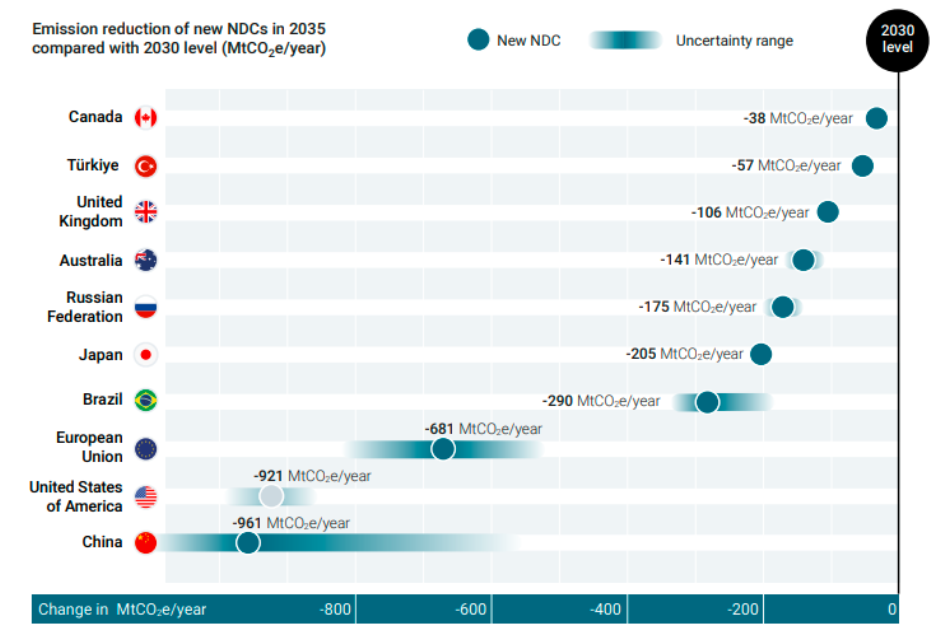The Emissions Gap Report 2025 reveals that greenhouse gas (GHG) emissions from G20 members, excluding the African Union, accounted for 77 percent of global emissions in 2024 – marking a 0.7 percent increase from the previous year. The United Nations Environment Programme (UNEP) report highlights that while the European Union was the only major emitter to cut emissions, India and China recorded the highest absolute increases, and Indonesia saw the fastest relative growth.
Despite the Paris Agreement’s requirement for countries to submit new or updated Nationally Determined Contributions (NDCs) by February 2025, progress remains slow. As of September 30, 2025, only 64 parties – representing 63 percent of global emissions – had submitted or announced new NDCs. Of these, just 13 countries, accounting for less than one percent of global emissions, strengthened their 2030 targets.
Limited Progress in Climate Commitments
While NDCs have become slightly more comprehensive, the pace of improvement is far below what is needed to achieve the Paris Agreement goals. Most of the progress came before the latest round of NDC submissions.
About 73 percent of new NDCs include renewable energy targets, but analysts warn that these may fall short of achieving the global goal of tripling renewable capacity by 2030. Market trends currently suggest only a 2.7-times increase. Similarly, commitments to double energy efficiency improvement rates are lagging – fewer than half of new NDCs contain such targets, and global efficiency gains have stalled in recent years.
Fossil Fuel Phase-Down and Investment Gaps
The response to fossil fuel reduction goals remains weak. Only 62 percent of new NDCs include targets to reduce fossil fuel use in the electricity mix, while 29 percent mention phasing down coal. None of the NDCs set clear goals to reduce oil and gas production or eliminate inefficient fossil fuel subsidies.
Investment signals in new NDCs are also limited. While some countries have improved the detail of their financing needs, most plans still lack clarity on capital requirements, sectoral pathways, or implementation strategies.
G20 NDC Targets for 2035
Seven G20 members – Australia, Brazil, Canada, Japan, Russia, the United Kingdom, and the United States – have submitted new NDCs with mitigation targets for 2035. China, the European Union, and Türkiye have announced their plans but not yet formalized them. None of the G20 members have strengthened their 2030 targets.
If fully implemented, the new 2035 NDCs are projected to reduce GHG emissions by around 3.6 gigatons of CO2 equivalent compared to 2030 levels. Collectively, G20 nations could achieve a reduction of approximately 4 GtCO2e. However, the upcoming withdrawal of the United States from the Paris Agreement in January 2026 could significantly alter this trajectory.
Current Policy Trends
Comparing NDCs with existing policy projections shows mixed progress. Overall, the new G20 NDCs could reduce 2035 emissions by 2.8 GtCO2e per year compared to current policy trends. The largest positive contributions come from Brazil and the United States, while some members’ targets remain less ambitious than their current policies.
Updated data for China show emissions likely peaking around 2025 before declining by up to 1.4 GtCO2e by 2030, mainly due to rapid renewable energy expansion. Conversely, U.S. emissions projections have increased by about 1 GtCO2e following recent policy rollbacks.
Implementation Gap Widens
The G20 remains off track to meet its 2030 NDC targets. The implementation gap – the difference between pledged and actual emissions reductions under current policies – stands at 2 GtCO2e for unconditional targets and up to 4 GtCO2e when adjusted for overachievement.
Only seven G20 countries are likely to meet their 2030 unconditional NDC targets with existing policies, while nine are either off track or uncertain. Some nations have narrowed the gap significantly, suggesting that stronger policies could help bring targets within reach.
The Emissions Gap Report 2025 underscores that while there has been incremental progress, global emissions remain far above the levels required to limit warming to 1.5°C. Stronger NDCs, rapid fossil fuel phase-outs, and clear investment pathways are critical to closing the climate ambition gap before the end of this decade.
Baburajan Kizhakedath

